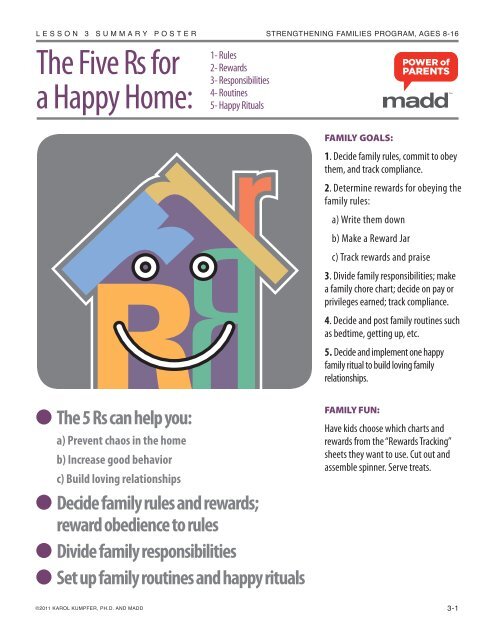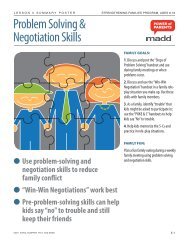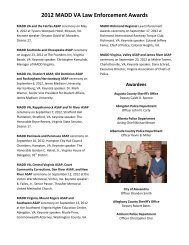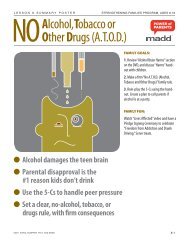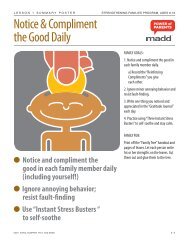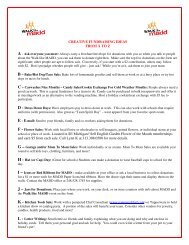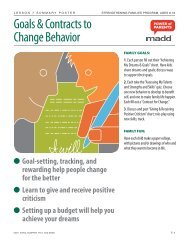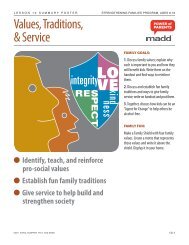The Five Rs for a Happy Home: - MADD
The Five Rs for a Happy Home: - MADD
The Five Rs for a Happy Home: - MADD
Create successful ePaper yourself
Turn your PDF publications into a flip-book with our unique Google optimized e-Paper software.
LESSON 3 STRENGTHENING FAMILIES PROGRAM, AGES 8-16Our Family Rules!Ideas our family has created to live by, that make us strongTogether as a family, create rules that establish rights and responsibilities, teach children pro-social values, and keep them safe. When children help makerules, they are more likely to obey them. Next, establish rewards <strong>for</strong> following family rules. <strong>The</strong> following week, add negative consequences <strong>for</strong> breakingthem. Rules that are fair, firm, and consistently rein<strong>for</strong>ced and en<strong>for</strong>ced, help children feel more secure and develop better self-control.Rule Reward Consequence12345678910©2011 KAROL KUMPFER, PH.D. AND <strong>MADD</strong> 3-2
LESSON 3STRENGTHENING FAMILIES PROGRAM, AGES 8-16Making Rewards RewardingLet your kids choose what rewards they enjoy mostFor rewards to rein<strong>for</strong>ce good behavior, kids have to find them actually rewarding. So ask kids what they like best, help them fill out this <strong>for</strong>m, anduse that <strong>for</strong> your guideline. <strong>The</strong>re are three types of rewards: Social Rewards, Privileges, and Material Rewards. Kids enjoy social rewards the most;but also enjoy earning privileges and things they want. When kids earn their rewards and privileges, they receive more pleasure from them than ifthey got them free. Distinguishing between a child’s rights (food, shelter, safety, clothing, education, and love) and privileges (everything else) willhelp you use things you are providing already, or new things kids want, as a rewarding reward.6Rules ofRewarding1. Make the Reward rewarding—and fit the size of the Reward to the amount of ef<strong>for</strong>t expended2. Reward immediately—but only AFTER the good behavior; never be<strong>for</strong>e or <strong>for</strong> future “promised” behavior3. Tell exactly what you liked4. Smile; be enthusiastic, show you are pleased5. Reward consistently when starting out; when behavior is well established, switch to sporadic rewards using dice.6. Don’t offer a reward to stop bad behavior. (Stop crying and I’ll give you a treat.) Trains kids to misbehave <strong>for</strong> rewards.Social RewardsA parent’s positive attention, time, andsincere praise; use “40 Phrases ThatPraise” handout from Lesson 1PrivilegesSpecial outings, TV time, video gametime, extra bedtime story, movies,getting a Drivers LicenseMaterial RewardsMoney, treats, things you buy, make,barter <strong>for</strong>, download, or sew©2011 KAROL KUMPFER, PH.D. AND <strong>MADD</strong> 3-3
LESSON 3 STRENGTHENING FAMILIES PROGRAM, AGES 8-16Family Responsibilities and ChoresTracking SheetUse this as a guide and worksheet. Pick a set day and time when all family members can attend, like a Sunday evening. List responsibilities and divide upfairly, according to age and ability. Supply training as needed.A long term study showed that kids who did assigned chores as children and teens were more responsible, competent, self-reliant and had higher selfesteemas young adults than those who did not. Research also showed that kids who do not have to do chores or help around the house were more likely tobe self-centered and at a greater risk <strong>for</strong> depression. (For great chore-assigning tips see: <strong>The</strong> Big Book of Parenting Solutions by Michele Borba.)WHO DOES WHAT WHENPerson responsible: Chore: To be completed by:©2011 KAROL KUMPFER, PH.D. AND <strong>MADD</strong> 3-4
LESSON 3 STRENGTHENING FAMILIES PROGRAM, AGES 8-16Chore ChartHelp kids become responsible by tracking and rewarding choresKids need a visual tracking chart to serve as a reminder and monitor progress. Use this or find online charts: www.kidsallowancebank.com or myjobchart.comKEEPING TRACK HELPS GET THINGS DONEName Chores When (Day/Week/Month) M T W Th F S S Reward©2011 KAROL KUMPFER, PH.D. AND <strong>MADD</strong> 3-5
LESSON 3 STRENGTHENING FAMILIES PROGRAM, AGES 8-16Stress-Busting RoutinesPositive routines reduce chaos, foster freedom and peaceEstablishing positive routines in each of the five areas below will reduce family stress, improve children’s emotional health, and assure that thethings most important to you get done. Together, decide set times and ways of doing things that work best <strong>for</strong> your family, and try to stick withthem. Problem-solve until you get the results you want.1. SleepBedtime Wake up Bedtime duties/hygiene2. Dinnera. Who buys food? When? (buy brain-healthy food; avoid junk)b. What’s <strong>for</strong> dinner? (plan weekly; include veggies, fruit, whole grains, lean protein)c. When is dinner? (weekdays) (week-ends)d. Who fixes food? and ande. Who cleans Up? and and3. Study, Learn, and Worka. <strong>Home</strong>work Study-Time Routine:i. Time (weekdays) Place: How long?ii. Time (weekends) Place: How long?b. Laundry:i. Who does it? Whenii. Who does it?Whenc. Practicing talents and skills (make charts with day, time, amount)d. Chores (make chore charts, list duties, when each is to be done)4. Play, Plan, Progress (“My Time”, Family Meeting, Personal Meetings, Exercise, etc.)a. Family Play-time One-on-One Play-timeb. Weekly Family Meeting (day) (time)c. Pleasant Personal Conference (days) (time)d. Exercise (thirty minutes, five days a week) What? When?5. FinancialPlan Income & Spending: Date Time Review it: Date TimeDescribe your plan to track spending©2011 KAROL KUMPFER, PH.D. AND <strong>MADD</strong> 3-6
LESSON 3STRENGTHENING FAMILIES PROGRAM, AGES 8-16<strong>Happy</strong> Family RitualsCreate special moments to increase family love and bondingA happy family ritual is a set way of saying or doing something that enhances an event’s meaning and promotes family bonding. <strong>The</strong>se includetender ways of greeting each other or ways to say, “I love you.” (“I love you bigger than the sky!”) Some families have a nighttime ritual that includesreading a bedtime story, or giving back rubs and songs to help a child feel loved and secure. As teens grow, it could be a special snack whencoming home from school while sharing the “best and worst part of the day;” or a quiet bedtime chat ending with, “I sure love you. Thanks <strong>for</strong> beingmy son or daughter.” <strong>The</strong>se moments help family members feel loved and appreciated. Whether your family ritual is daily—like pausing tenderly togive welcome home hugs, a special greeting, and a long look into a child’s eyes; or kisses whenever you see a rainbow—be sure to do it happilyand regularly, so kids can count on it.Below, list the happy family rituals you already have and ask: “Are our happy family rituals adequate to produce family bonding? How can we makethem more meaningful? What happenings occur on a daily or weekly basis that we could enhance with a loving moment?” Get family input; writedown your ideas. <strong>The</strong>n begin another happy family ritual.Our <strong>Happy</strong> FamilyRitualsNew <strong>Happy</strong> Ritualsto Begin<strong>Happy</strong> Family RitualIdeas• Greeting: special saying: “What did youbring home from school today—besides yourbeautiful brown eyes and your happy sweetsmile?”; take time to kiss• Departing: group hug; special sayings: “Makeit a great day!”, “Give me four things: a kiss, ahug, a high-five, and a ‘I love you!’”• Nighttime: songs, stories, back rubs, hugs,calm music, prayers• Morning: hugs, music, exercise• Mealtime: “compliment the cook”; ask ablessing; use Conversation Jar• Sharing Values: memorize a saying, add astar to the Values Chart• Spiritual: prayer, reading an upliftingthought or verse of scripture, lighting candle• Holiday: hang valentines in bedroom doorway;put a special star on a Christmas tree <strong>for</strong>each child and share story of their birth, andwhy they’re special to you• Seasonal: sharing spring tulips or daffodils;raking fall leaves and jumping in the pile• Memorial: singing a departed loved one’sfavorite song while placing a flower onhis or her grave• Other: special hand-squeeze that means,“I love you”©2011 KAROL KUMPFER, PH.D. AND <strong>MADD</strong> 3-7
LESSON 3 STRENGTHENING FAMILIES PROGRAM, AGES 8-16Reward JarRewarding good behavior by providing positive consequencesWe all like to receive recognition and rewards when we per<strong>for</strong>m well or doa good deed. <strong>The</strong>se motivate us to repeat such actions. Write in the spacesbelow various rewards that family members would like to receive <strong>for</strong> completingthe “Family Responsibilities” worksheet as well as other behaviorsyou would like to encourage. Make sure these are rewards you and yourchild agree on. When a child does well, IMMEDIATELY PRAISE AND SAYTHEY EARNED A REWARD SLIP. Allow them to pick it immediately or havean appointed family time when the child can choose a reward from the jarand be praised in front of the family.REWARDSWAYTO GO!GoodBehaviorPays OffFamily Fun: Have your kidsdecorate a Rewards Jar. <strong>The</strong> followingitems can be helpful:• Colored paper, cloth, or paint• Family photos• Pictures of rewards (like an icecream cone, video game time,etc.) cut out from magazinesor drawn by the child©2011 KAROL KUMPFER, PH.D. AND <strong>MADD</strong> 3-8
LESSON 3 STRENGTHENING FAMILIES PROGRAM, AGES 8-16Tracking Rewards <strong>for</strong> Good BehaviorIntroductionTHE CONCEPT: One of the best waysto change behavior is to pay attention and toreward the behaviors you want and ignore thoseyou don’t want.<strong>The</strong> benefits of rewards can be enhanced bymaking earning the reward entertaining andintroducing an element of surprise—a randomreward. Picking rewards that are attractive to thechild is critical. It is best to sit down with yourchild and make a list of the rewards they wouldlike. Some can be small <strong>for</strong> smaller achievementsand some can be larger <strong>for</strong> significant progress.As behavior changes <strong>for</strong> the better, you canchoose new behaviors to work on and reward.Change the rewards over time to keep yourchild’s interest and desire.<strong>The</strong> primary elements of “playing up goodbehavior” involve these 2 components:1. A chart to track the behavior(s) you want tochange.2. A device such as a spinner or dice tocreate an element of luck in determining whichreward the child receives.<strong>The</strong> handouts on the following pages giveexamples and templates of charts and randomreward devices to use. Or, create your own chartsand reward devices.GETTING STARTED: First choose thebehavior you wish to change. How can it bemeasured? How often will your child get to noteprogress?You will have more success if you begin with abehavior which is not too hard <strong>for</strong> your child toachieve. You can then build from this success andtackle more difficult behaviors.Be clear about what your child must do to earn amove on the chart and receive a reward.Let’s use Ben, an eight-year-old child, who has ahard time cleaning his room as an example. Howcan progress in cleaning his room be measured?We could break “clean room” into three parts:1) bed made, 2) clothes away, and 3) toys away.Ben already makes his bed sometimes; this is goodbecause we know he will get at least some rewards.Together, Ben and his parents decide that “bedmade” means that the sheets, blanket and thebedspread must be pulled up and off the floor.“Clothes away” means all dirty clothes in thelaundry basket, with clean clothes put away andnone left on the floor. “Toys away” means that alltoys must be in the toy box. <strong>The</strong> parents decide tocheck Ben’s room each day at 7:30 p.m., one-halfhour be<strong>for</strong>e bedtime.Ben chooses to use a “Dot-to-Dot” chart. (Seefollowing pages <strong>for</strong> examples.) <strong>The</strong>y decide thatBen should receive a reward every other day. <strong>The</strong>ycircled every fifth, sixth, or seventh dot in red;whenever Ben reaches a circled dot, he earns asmall reward.When choosing rewards with your child, be surethey will be easy to give. <strong>The</strong> rewards should be usedonly <strong>for</strong> the chart and not <strong>for</strong> any other behavior.Decide on an extra special reward to give <strong>for</strong>finishing the chart such as a movie with a parent,a special toy, or going out <strong>for</strong> pizza.Parents using very long “Dot-to-Dot” charts havesuggested dividing the chart into sections, with aspecial activity at the end of each section.Put the chart and random reward device in aplace where they will be easily seen. Ask yourchild to describe what behavior he or she mustdo and what rewards he or she can earn. Beinterested and enthusiastic when your childmarks her or his chart so your child will be moreeager to participate and please.TIPS FOR SUCCESS IN USING CHARTS AND RANDOM REWARDS1. Check your child’s chart each day at thetime you set. Be sure your child is there andparticipating.2. Look <strong>for</strong> something you like and say so. Donot scold <strong>for</strong> missed behaviors. Your child willsimply miss a chart move and spinner <strong>for</strong> theday. Be sure your child knows what he or shedid right and understands what is expected.3. Ignore your child’s arguing or begging in anef<strong>for</strong>t to get the rewards without complying.4. Be sure the child gets the reward he or sheearned that day NO MATTER WHAT!5. Don’t give any of the rewards at any othertime <strong>for</strong> any other reason. (If they get themanyway, why should they work?)6. DO NOT take away an earned star or move <strong>for</strong>unwanted behavior.7. Change the behaviors on the chart after yourchild learns to do them well.8. Change rewards occasionally to keep yourchild’s interest high.9. Keep it happy and fun.©2011 KAROL KUMPFER, PH.D. AND <strong>MADD</strong> 3-9
LESSON 3 STRENGTHENING FAMILIES PROGRAM, AGES 8-16Tracking Rewards <strong>for</strong> Good BehaviorBee Good ChartThis chart is primarily <strong>for</strong> young children. You can use any kind of stickers—flowers or bees might be nice, or draw them in. Place a sticker on the poster eachday that the task or behavior is achieved. Behaviors could be making the bed, brushing teeth, putting clothes away, etc.Bees are known <strong>for</strong> their hard work and their positive effect on much more than their own family or hive. A hive is like a home—everyone has a job to do tomake the family run happily and well. If everyone does their part, pure sweet honey is the reward.Better beehavior beegins with me.SUNMONTUESWEDTHUFRISATGOOD BEHAVIORS GOOD BEHAVIORS GOOD BEHAVIORSBEHAVIORS©2011 KAROL KUMPFER, PH.D. AND <strong>MADD</strong> 3-10
LESSON 3 STRENGTHENING FAMILIES PROGRAM, AGES 8-16Rewards Tracking <strong>for</strong> Good BehaviorHigh-5sHere’s a chart that can be used <strong>for</strong> young children or even older ones. Use a star to mark each day that a task or behavior is achieved. Behaviors could bedoing a chore, meeting curfew, doing homework on time, etc.An alternative to using stickers is using a rating system. For example, you can rate the per<strong>for</strong>mance from 1-5, 5 being excellent and 1 the least acceptable.Write the score on the poster each day. At the end of the week add up the score. Pick a minimum score, such as 25 or 28 that earns the reward. Give a bonus<strong>for</strong> extra high points.BEHAVIOR: SUN MON TUE WED THU FRI SATBEHAVIOR: SUN MON TUE WED THU FRI SATBEHAVIOR: SUN MON TUE WED THU FRI SAT©2011 KAROL KUMPFER, PH.D. AND <strong>MADD</strong> 3-11
LESSON 3 STRENGTHENING FAMILIES PROGRAM, AGES 8-16Tracking Rewards <strong>for</strong> Good BehaviorBrain Gain ChartWhen we improve our behavior by learning and practicing a new skill, we wire our brain to be more effective. Decide how often to give a reward bycircling with a colored pen or pencil certain dots, such as every third or fourth dot. Have your child draw a line between the dots as he or she accomplisheswhat is expected.What seems like the end...3735363433323031...is only the beginning ofsomething better292827262122202323222425191816171513141211910876REWARD:What I will do to earn the reward:3452All progress starts1with the first step©2011 KAROL KUMPFER, PH.D. AND <strong>MADD</strong> 3-12


